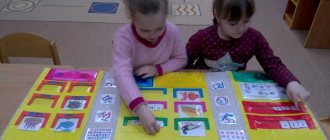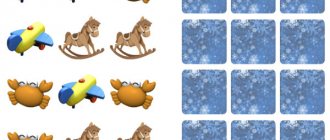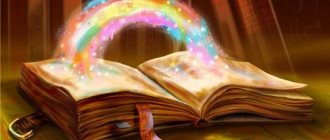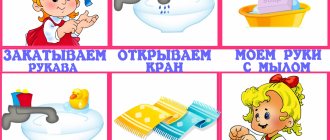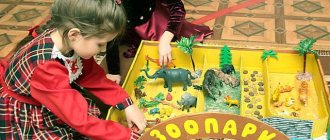Progress of the game: The teacher explains to the children the rules of the game:
O – Now let’s play the game “Friendly Guys”
.
Get into pairs. Now line up in two columns. The first column is squirrels, the second is fox cubs. Here are your houses (the teacher places chairs at different ends of the hall, on which he places the squirrel and the fox). When you hear dance music, you will dance and run and frolic on the lawn. With the command “Wolf in the forest!”
everyone run to your mothers. Those who get it together sooner will win. The game is repeated three or four times.
Two brothers
Objectives: To develop the ability to correlate and use aspectual pairs of verbs speech
Visual material: Toys: bear cubs Shustrik and Myamlik.
Distance education
Planning work on ZKR in the junior group
- Main areas of work:
- Formation of correct pronunciation
- Development of auditory perception, phonemic hearing
- Development of prolonged oral exhalation, speech breathing
- Work on intonation expressiveness of speech (voice height and strength, word stress, diction development)
- Development of fine motor skills
- Recommendations for planning work on ZKR:
- As an element of speech development in educational areas, it is carried out 2 times a week
- In the calendar plan, work on the development of the respiratory system (breathing, auditory attention, intonation) is taken into account daily
- Fine motor skills are also developed daily
- Individual work must be reflected in planning
- Planning for working with sounds:
Didactic games and exercises:
- Games for the formation of correct pronunciation of sounds - 7c, pp. 54-95, speech therapy lotto, dominoes,
- “Magic cubes” (for onomatopoeia and articulation),
- “Magic bag”, “Sound clock”, “Fishing” (7d, p. 28),
- "Logical Train"
- “Who will pack their things faster?” (7d, p. 49),
- “Pick up a bouquet” (7d, p.52),
- “Find a Pair” (7d, p.53), “Shop” (7d, p.50),
- “Train” (7d, p. 61),
- “Find a place for the picture” (7d, p.29),
- “Magic Wand” (7l, p.24),
- “Whose story is better?” (7c, p.99),
- “Let's go for a ride in the car” (7b, p.27),
- “Name the products” (76, p. 141),
- “Guess the last word” (addition of poems, phrases - 7e p. 59),
- “Who will see more?” (finding words with a given sound in the picture),
- “Who is more faithful and faster?” (you can work similarly with any sounds) (7e, p.30),
- “Who will remember more?” (selection of any words - all parts of speech - with a given sound),
- “Who will hear more?” (selecting words with a given sound from a listened text), making sentences based on plot pictures, stories based on a series of pictures, staging fairy tales.
- Games and play exercises used to develop general speech skills:
- Development of auditory attention , speech and phonemic hearing:
It is necessary to have sounding toys and music in the group. instruments (hammers, bells, metallophone, tambourine, pipes, drum, rattles...) Work on reproducing a series of sounds. Practice the ability to reproduce a series of sounds at different tempos.
Didactic games for the development of auditory attention:
- “Repeat after me” (“Parrot”, “Tape recorder”),
- “Seller and buyer” (7d, p. 16),
- “Telephone” (7 l, pp. 89,94), “Who heard what?” (7g, p.15,16),
- “Who called?” (7g, p.22),
- “Where does it sound?” (7g, from 15),
- “Blind Man’s Bluff” (with sounding objects, with a voice - 7g, p. 18),
- "Whose voice?" (birds and animals - 7g, p. 21),
- “Who hears better?” (7 l., p. 89), “Echo” (7 l., p. 89),
- “Commotion”, “Wind and Birds”, (“Sun and Rain” - 7g, p. 19,20),
- “Snail” (7d, p.22),
- “Frog” (7d, p.22),
- “Find the mistake” (7b, p.25), poems, fables...
Didactic games for the development of phonemic hearing:
- “What sound does your name begin with?”
- “Find the mistake and say the word correctly” (76, p. 151),
- “Rhymes” (desktop-printed and oral version), “Damaged phone”, “Highlight with your voice” (the child pronounces a word with the voice highlighting a given sound - xxtail, mehhh,...) + d/i from point No. 3
- Development of the articulatory apparatus:
At this age, articulatory gymnastics is very effective! It is recommended to include 1-2 minute articulatory exercises daily at any routine moments: after exercise, after sleep, as pauses for rest.
Required:
- cards of games and exercises for articulatory gymnastics (7c p. 32-39, 7e, 7d, 7m p. 125)
- fairy tales about the “Merry Tongue” (7l pp. 31,53,79,111; 7d;…)
- material containing a description of the structure of the organs of articulation when pronouncing the sounds being studied (7i, 7e)
- Development of long exhalation, speech breathing:
The group should have games and play material for the development of long-term smooth exhalation (tissue paper aids, leaves, snowflakes, pendant toys, pinwheels, light blowing toys, inflatable toys, balloons, soap bubbles, pieces of cotton wool, pipes,...) It is necessary to make a card index of games and breathing exercises.
Didactic games for developing long exhalation:
- "Footballers"
- “Whose snowflake... will fly next?” (7g, p.40),
- “Pump”, “Lumberjacks”, “Whose steamboat hums better?” (7g, p. 40), “
- “Recognize by smell” (any aromas - 7g, p. 40),
- “King of the Winds”, “Gurgling” (blowing into water through a straw), “Who is stronger?” (to blow off a light scarf... - 7 l, p87),
- "Bubble." (differentiation S - Ш - 7g, p. 42),
- “Blizzard” (“Beep” - 7g, p. 51)
Didactic games for the development of speech breathing:
- “Come up with a phrase” (7d, e.44),
- “Name your neighbors” (7d, p.44),
- “Echo” (repeat the phrase in 3-5 words),
- “The Magic Mirror” (7d, p.45),
- “Locate the place of the toy” (7d, p.49),
- "Who will win?" (7d, p.52)
- Work on the expressiveness of speech: (tempo, rhythm, verbal and logical stress, diction...):
Practicing the pronunciation of tongue twisters, tongue twisters, poems (choose words with a complex syllable structure).
Dramatization games: “Three Bears”, “Wolf and Seven Little Goats”, “Bear and Christmas Tree” - 7v pp. 53,54).
Round dance games, role-playing games: “Guests”, “Bus”, “Mail”, “Telephone”,…. “Say a phrase with ... mood”, “Isolate a word in a phrase with your voice”, “Your mood”, “Cat and mice” (children are forced to speak slowly), “Blizzard” (7d, p. 51), “Dashes” (7c .51), “Guess which train” (7b p.36)
- Development of fine motor skills:
The group must have:
- card index of finger games, speech with movement
- various mosaics with small details, construction sets, large beads, ...
- aids for fastening buttons, lacing
- tutorials for shading, stencils, labyrinths, stamps, “Lay out a pattern from sticks”
Didactic games for the development of fine motor skills:
- "Piano",
- "Magic bag"
- “Find a pair” (buttons or other paired small items),
- “Dry finger pool” (7i, p. 74),
- “Clothespins” (7i, p.67),
- “Make a chain (paper clips)”, “Finger theatre”, “Shadow theatre”, “Forfeits”, “Drawing with scissors” (7i, pp. 69,75),
- “Embroiderers” (7i, p. 70),
- “Find a surprise” (7i, p.66),
- “The Little Pharmacist” (7i, p.69),
- “Colored drops” (7i, p. 68), “Wind up a ball”, “Motley rug”
- Organization of the ZKR corner:
- For the corner it is necessary to allocate a specific place where the following should be collected:
- systematized speech and visual material
- card files of games and exercises. for the development of fine motor skills
- card files of games and exercises. on the development of breathing
- card files of articulation exercises
- card files of games and exercises. on the development of breathing
- card files of games and exercises. on the development of auditory and speech attention
- card file of speech material for working with studied sounds
- Material for the development of fine motor skills should be accessible to children (except for very small parts)
- The corner is replenished monthly:
- speech and visual material according to planning
- material for the development of general speech skills and fine motor skills according to these recommendations at the discretion of the teacher
- any training session for working with sounds (one) and for developing general speech skills (one)
- Recommended reading:
- A. Efimenkova L.I. “Speech Formation in Preschool Children”
- b. Maksakov A.I. “Is your child speaking correctly?”
- V. Maksakov A.I., Tumakova G.A. "Learn by playing"
- Ed. Seliverstov V.I. “Games in speech therapy work with children”
- D. Shvaiko G.S. “Games and play exercises for speech development”
- E. Aksenova A.K., Yakubovskaya E.V. “D/i in Russian language lessons in grades 1-4. aux. school."
- and. “Tru-la-la” from the series “Karapuz”
- h. Budennaya T.V. “Speech therapy gymnastics”
- And. Galanov A.S. “Mental and physical development of a child from 3 to 5 years old”
- K. Borodich A.M. “Methods for the development of children’s speech”
- l. Khvattsev M.E. “Speech therapy work with preschool children”
- m. Ed. Ushakova O.S. “Speech development classes in the Danish garden”
- n. Gerbova V.V. “Classes on speech development in the senior group”
Speech therapist teacher
E. S. Mikushina , highest qualification category
| Methodical piggy bank |
Progress of the game: A bear cub comes to visit the children. Children surround him.
– The little bear knows how to carry out instructions. You can ask him: “Teddy bear, lie down on your side.”
,
“Lie on your back”
,
“Lie on your tummy”
.
And he can also sing. Ask: “Bear, sing
.
This is how the bear sings. Liked? (The words are accompanied by actions with the toy.)
At the request of the children, the bear performs various tasks. If the child is silent, the teacher asks leading questions.
O - Do you want the bear to lie down? On your tummy or on your back? Let's ask together: “Teddy bear, lie down on your tummy.”
.
You can give other tasks to the bear: “Go (down the hill)
",
"Jump"
,
"Dance"
, etc.
Lost
Objectives: Learn to correlate the name of an animal and its baby.
Visual material: Toy house. Animals (toys)
: duck - duckling, hen - chicken, goat - kid, cow - calf, horse - foal.
Progress of the game: The teacher places toys in different places in the room: a duck, a chicken, a goat, etc. There is a toy house on the carpet: “Who lives in the little house?”
- Let's get a look. "Quack-quack-quack"
, - who is this?
Duck? (Takes it out of the tower.)
Big and small?
Small? These are the duckling guys. Little duckling. And his duck is his mother. Help the duckling find his mother duck. Vasya, take the duckling. Look for the duck. (The child walks around
the group , looking.) And whose voice is this: “Pee-pee-pee”
?
Who is this? (Takes out a chicken.)
Who is the chicken's mother? How does a chicken cackle? How does the chicken respond? Look, Olya, for the chicken, the chicken’s mother. Etc.
When the children find mothers for all the babies, they plant the toys in pairs. Children look at them, call them: duck - duckling, hen - chicken, etc. The animals are put in a car (or train)
and taken away to visit other children.
Whose voice?
Objectives: Distinguish between animals and their young by their “voices”
. Match their names correctly.
Visual material: Toys: mouse - little mouse, duck - duckling, frog - little frog, cow - calf.
(come) to visit the children
animals. The animals want to play. You have to guess whose voice is sounding.
– "Mu"
, oh - who moos like that?
(Cow.)
Who moos lowly?
(Calf.)
- “Kwa-kwa”
o – whose voice?
Is that a rough voice? And who croaks subtly? (Little frog.)
The frog is large, croaks in a rough voice.
And her cub croaks thinly. Who is the baby frog? (Little frog.)
etc.
After the game, children can play with toys. To do this, you need to call the animal correctly: “Frog, come to me.”
,
"Duckling, come to me"
.
House for animals
Objectives: To intensify the use of names of baby animals in speech .
Visual material: A tray with toys depicting baby animals: squirrels, hares, ducklings, mice, etc. - according to the number of children. Construction material.
Progress of the game: The teacher brings in a tray of toys. Children surround him.
O – Animals came to visit us. Today we will build a house for them. Want to? Choose who you will build the house for and ask correctly: “Please give me a duckling.”
or
“Please give me a baby squirrel
.
O - Who should I give you, Olya? And you?
The child receives a toy if he names the cub correctly. If necessary, the teacher suggests a word or its beginning and asks to repeat the name.
Construction material is laid out on the carpet. Children build houses for their animals and play with them.
Order
Objectives: Exercise in the formation of imperative forms of verbs. Intensify the use of the names of baby animals in speech .
Visual material: Toys: squirrel and kitten.
Progress of the game: Meowing is heard.
- Who is that meowing? Where is he (He goes out to the locker room with the children.)
- Guys, guests have come to us! Look, they are very small. It's not just a squirrel and a pussy. This is a kitten and a baby squirrel.
The animals want to play with you. They can be given instructions. If you ask correctly, the baby squirrel will jump. “Little squirrel, jump!”
That's how it jumps! And you can ask the kitten:
“Kitten, sing!”
This is how a kitten sings. Who do you want to ask? About what?
After the game, the animals say goodbye to the children and leave (leave)
.
Friendly guys
Objectives: To consolidate the ability to correlate the names of animals and their young. Intensify the use of these names in children's speech .
Visual material: Toys: squirrel and fox.
